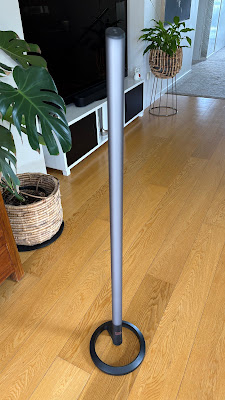
When it comes to heritage brands in tech, JBL is right up there.
Decade after decade, professionals and consumers alike have turned to JBL for fantastic sound solutions and in the age of portable and Bluetooth speakers, JBL has come to the party every time. Literally.
While the resulting sound performance has always exceeded expectations, I don't think anyone ever bought a JBL PartyBox specifically for its dazzling light show.
Now, recognising it's fun to add a bit of light and colour to proceedings, JBL has taken things in a new direction.
This is the first time I've reviewed any JBL device that doesn't play music.
If the PartyLight Beam and PartyLight Stick are anything to go by, it certainly won't be the last.
The first thing I love about these two devices is there's nothing particularly fiddly about them. The Stick couldn't be easier to assemble; you literally just twist and click the LED light tube into place on its stand, while the Beam requires no assembly at all.
The Stick comes with a USB-C charging cable in the box but no wall charger, so it's assumed you'll already have one of those lying around. It'll take up to 3 hours to fully charge the 9.0Wh lithium-ion battery which should then give you about 8 hours of continuous use.
Both lights are easy to pair, using the JBL PartyBox app. Although you don't actually need the app to use them, it is recommended you check for any firmware updates before you do. These updates take an annoyingly long time to download and install, presumably because you're only connected to your phone or tablet via bluetooth. Take my advice, don't try and install an update 5 minutes before your guests are due to arrive.
Once that's over and done with though, the rest is easy.
AFter you've plugged it in, the Beam is powered on by tilting it up to face your preferred direction. The Stick has a power button, which causes a section of colour to rise up its tube like a light-sabre, before briefly showing you how much charge is left with a white-on-black indication.
Both Stick and Beam have built-in mics and using JBL's algorithm, they listen to whatever music's playing and react accordingly.
The Stick creates all kinds of mesmerising effects, sending shafts of different colours up and down the tube at various speeds, while the Beam combines two different, extremely bright, rotating LED spotlights to project an infinite combination of colours and patterns onto your wall or ceiling.
That's fun but it's a bit random - especially if you're using both devices together like I am for this review.
Using the PartyBox app, you can customise the colours and patterns exactly the way you want but the real fireworks start when you add a JBL PartyBox into the equation.
One caveat here; it'll need to be a relatively up-to-date PartyBox - because we're about to make use of the Auracast function.
I've talked about Auracast in my recent JBL speaker reviews. It's the latest protocol JBL has adopted to link multiple speakers together so they can create a louder, more powerful sound system.
The reason the new PartyLights also have an Auracast button is to connect and sync with a speaker like the PartyBox Stage 320 I reviewed back in May. These JBL speakers put on quite a cool light show of their own, although as I said in my introduction, it's kind of limited.
Now, with a press of the Auracast button, not only will any PartyLight devices be in sync with each other, they'll also match what's happening behind the grille of the speaker (or speakers).
This instantly makes your light show look far more professional, matching the tone and beat of the music with similar colours and effects. The Beam casts very bright patterns indeed, rated to light up a 40sq/m room with ease, while the Stick is uniquely designed to cast its effects in a full 360° array.
And unlike the Beam, the Stick also has the advantage of being completely portable, so there's nothing stopping you taking the party outside - especially if you've paired it with a rechargeable speaker like the PartyBox Club 120 I used for this review.
I've often talked about my disdain for pointless flashing lights on gadgets in the past - including perhaps the token light displays manufacturers like JBL insist on building into their speakers.
However...
By adding one or more devices from the new PartyLight range and syncing them up through Auracast, suddenly it all starts to make a lot more sense. The colours and patterns being projected by either the Beam or the Stick (or in my case, Beam combined with a pair of Sticks) now mimic the PartyBox speaker's display exactly.
Unfortunately, despite how universally all JBL's Auracast speakers connect together, no matter what size or model, only the PartyBox speakers with Auracast will sync with the PartyLights and sadly, if you have an older, non-Auracast PartyBox, you'll just have to rely on the PartyLights' built-in microphones to put on the show for you.
Either way these are a quick and easy way to bring a professional standard of lighting to your party - or perhaps even your gig if you're using a PartyBox or two as a P.A. What's more, they're durable, easy to move about and are pretty reasonably priced too. Why hire lights for your next function when JBL has come up with a fun, affordable solution you can own yourself?
Click here for more information and pricing on the JBL PartyLight Bean.
Click here for more information and pricing on the JBL PartyLight Stick.
Take your Radio, Podcasts and Music with you














